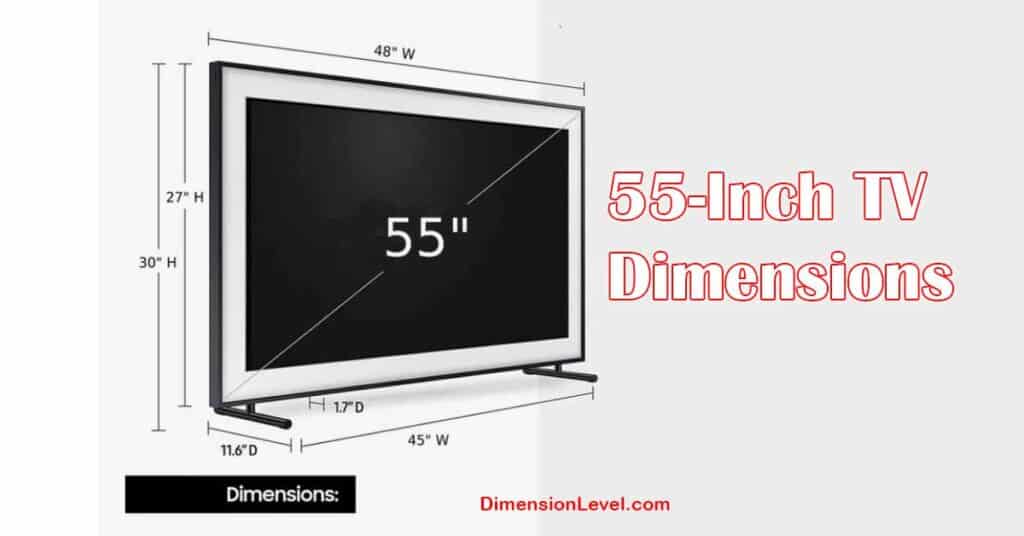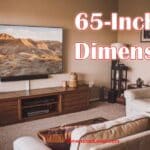A 55 inch TV refers to the diagonal measurement from one corner of the screen to the opposite corner. The actual width of these TVs typically measures around 48 inches, while the height is usually 28 inches. Modern 55 inch TVs use LED, QLED, or OLED technology and feature a standard 16:9 aspect ratio for optimal viewing experience.
Imagine trying to fit your new TV through a narrow doorway, only to find it won’t make the turn. Or picture mounting your TV on the wall, but discovering it’s too big for your space. These common scenarios make understanding TV dimensions crucial before making your purchase.
Today’s 55 inch TVs offer the perfect balance between screen size and room compatibility for most living spaces. They provide an immersive viewing experience from 7-11 feet away, making them ideal for average-sized living rooms. These TVs typically weigh between 35-50 pounds and can be easily mounted or placed on a suitable TV stand.
Understanding TV Dimensions
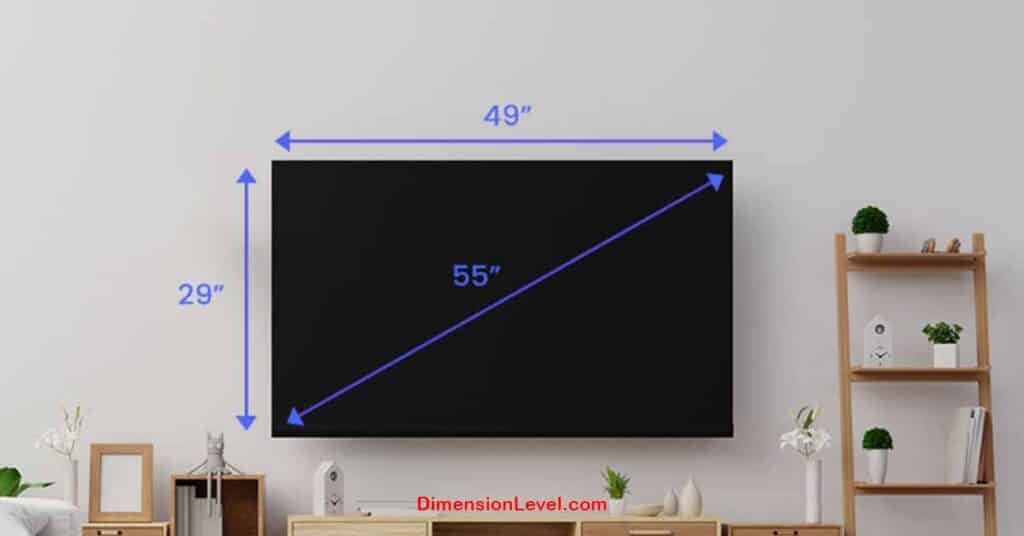
When diving into the world of 55 inch TVs, it’s crucial to understand that the advertised size refers to the diagonal screen measurement. Let’s break down the actual dimensions that matter for your space planning.
Standard Dimensions of a 55 Inch TV
| Measurement Type | Typical Dimensions |
| Screen Width | 47.9 inches |
| Screen Height | 27.0 inches |
| Diagonal | 55 inches |
| Depth (LED) | 2.75-3.5 inches |
| Depth (OLED) | 1.8-2.5 inches |
| Total Weight | 35-50 pounds |
Aspect Ratio and Its Impact
Modern 55 inch TVs use a 16:9 aspect ratio, which determines the relationship between width and height. This standardized ratio ensures:
- Optimal viewing of HD content
- Consistent display format
- Minimal black bars during playback
You Might Also Like 70 Inch TV Dimensions Width, Height, Depth (Easy Guide)
TV Stand Types and Styles
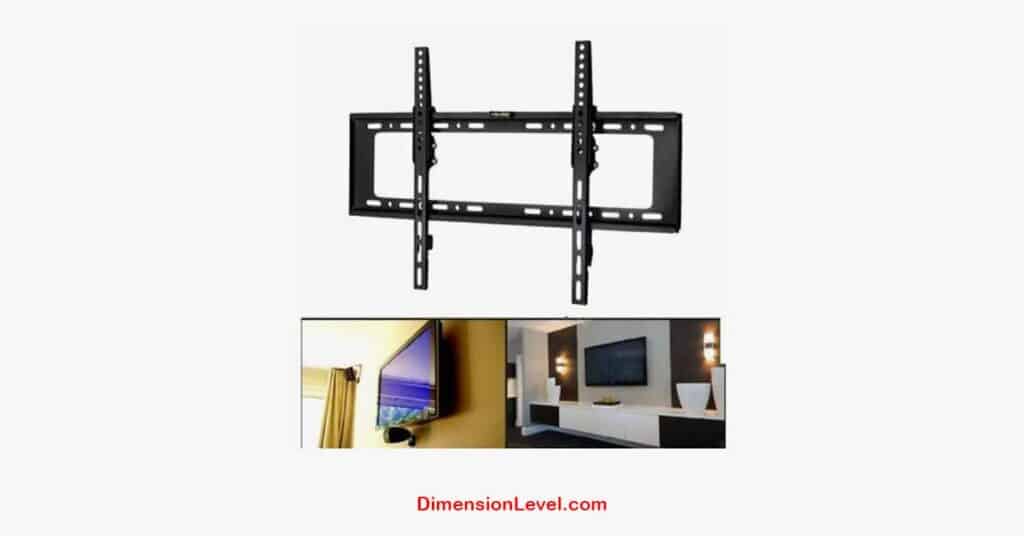
When choosing a TV stand for a 55 inch TV, the style matters as much as the size. From sleek modern designs to rustic industrial options, the right stand elevates your space, adds storage, and enhances your viewing experience. Let’s explore the best types and styles!
Traditional TV Stands
Traditional stands offer:
- Substantial storage space
- Classic design elements
- Typical height: 24-30 inches
- Width range: 50-65 inches
Modern TV Stands
Features of contemporary stands:
- Minimalist design
- Glass or metal construction
- Built-in cable management
- Smart storage solutions
Floating TV Stands
Benefits include:
- Space-saving design
- Modern aesthetic
- Wall-mounted configuration
- Typical weight capacity: 100-150 pounds
Industrial TV Stands
Characteristics:
- Metal and wood construction
- Enhanced durability
- Higher weight capacity
- Rustic aesthetic
Practical Considerations
Beyond style, practical details like cable management, storage, and durability can make or break your TV setup. Choosing wisely ensures a clutter-free, safe, and long-lasting home entertainment experience. Ready to dive into the must-know tips and features?
Cable Management
Essential cable management features:
- Integrated wire channels
- Back panel openings
- Cord covers
- Power strip storage
Storage Options
Modern TV stands offer:
- Component shelving
- Media storage
- Gaming console space
- Hidden storage compartments
Material Durability
Popular materials ranked by durability:
- Tempered glass
- Solid wood
- Metal frames
- Engineered wood
- Composite materials
You might be Interested 75 Inch TV Dimensions- Size, Width, Height (Easy Guide)
Optimal Viewing Experience
A key part of setting up your 55 inch TV is determining the best viewing distance and angle:
Recommended Viewing Distances
| TV Resolution | Ideal Viewing Distance |
|---|---|
| 1080p HD | 7 – 11.5 feet |
| 4K Ultra HD | 4.5 – 7 feet |
Sitting too close can cause eye strain, while sitting too far may reduce the perceived picture quality.
Viewing Angles and Picture Quality
Most 55 inch TVs offer 178-degree viewing angles, ensuring the picture remains clear and vibrant from different seating positions. However, viewing at extreme angles may slightly degrade picture quality.
Measuring Your Space
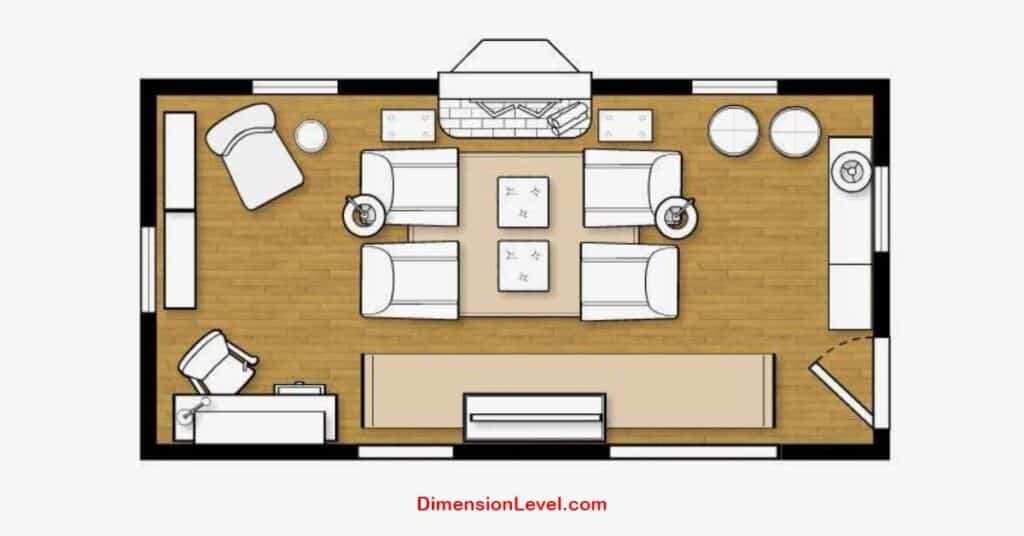
Before buying a 55 inch TV, proper space measurement is key. A misfit can disrupt your room’s layout and viewing comfort. With a few smart tips, you can ensure the perfect fit. Ready to learn how to measure your space like a pro? Let’s get started!
Room Size Requirements
Minimum room dimensions for optimal viewing:
- Width: 8 feet
- Depth: 10 feet
- Ceiling height: 7 feet
Furniture Placement Guidelines
- Primary seating: 7-11.5 feet from screen
- Side seating: Within 40° viewing angle
- Traffic flow: 3 feet clearance
- Soundbar placement: 2-4 inches clearance
Installation and Transportation
Installing and transporting a 55 inch TV can be tricky without proper planning. From navigating tight hallways to safe mounting, the process requires smart strategies. Want to avoid common pitfalls and set up your TV seamlessly? Let’s dive into the best tips!
Doorway and Hallway Measurements
Minimum clearances needed:
- Doorway width: 32 inches
- Hallway width: 36 inches
- Turning radius: 40 inches
- Stairwell width: 40 inches
Transportation Safety Tips
- Keep TV upright during transport
- Use original packaging when possible
- Secure TV with straps
- Add corner protection
- Use furniture blankets for padding
Wall Mounting Specifications

Wall mounting a 55 inch TV gives a sleek, modern look, but choosing the right mount type and ensuring VESA compatibility is crucial. The wrong setup can ruin the experience. Want to know how to mount your TV safely and stylishly? Let’s get into the specs you need!
Types of Wall Mounts
Available mount styles:
- Fixed mounts: Closest to wall
- Tilting mounts: 5-15° adjustment
- Full-motion mounts: Complete articulation
- Corner mounts: Space-saving solution
VESA Pattern Compatibility
Common VESA patterns for 55″ TVs:
- 200x200mm
- 300x300mm
- 400x400mm
Explore this 50 inch TV dimensions – how big is a 50 inch TV?
Environmental Considerations
Buying a 55 inch TV isn’t just about size and features; it’s also about making eco-friendly choices. From energy efficient models to responsible disposal, every decision matters. Curious how you can enjoy great tech while reducing your carbon footprint? Let’s explore!
Energy Efficiency
ENERGY STAR rated TVs typically:
- Consume 27% less power
- Average 100-200 watts during use
- Cost $30-50 annually to operate
- Save 60-70% in standby mode
Disposal and Recycling
Proper disposal methods:
- Manufacturer take-back programs
- Electronic recycling centers
- Certified e-waste handlers
- Donation to charities
Future-Proofing Your TV Space
Consider these factors:
- Upgradeability potential
- 8K resolution compatibility
- Smart home integration
- Multiple device connectivity
Key Takeaways
- Accurate measurements are crucial for proper fit
- Consider viewing distance for optimal experience
- Choose appropriate mount or stand type
- Plan for proper ventilation
- Account for cable management
- Consider future upgrades
Optimal Viewing Experience for 55 inch TVs

Getting the most from your 55 inch TV means more than just placing it in the room. The right viewing distance, angle, and sound setup can transform your experience. Want to unlock cinema-quality visuals and immersive sound at home? Let’s dive into the perfect setup!
Recommended Viewing Distances
The optimal viewing distance varies based on resolution:
| Resolution | Minimum Distance | Maximum Distance |
| 1080p HD | 7.0 feet | 11.5 feet |
| 4K Ultra HD | 4.5 feet | 7.0 feet |
| 8K | 3.5 feet | 5.0 feet |
Viewing Angles and Picture Quality
Understanding viewing angle impact:
- Optimal viewing cone: 30-40 degrees
- Maximum viewing angle: 178 degrees
- Color shift begins: Beyond 30 degrees
- Brightness reduction: Progressive after 15 degrees
“The sweet spot for viewing a 55 inch TV is directly centered at eye level, approximately 42-48 inches from the floor to the middle of the screen.”
Read More About How Wide is a 60 Inch TV?
Size Variations Across Brands
Not all 55 inch TVs are created equal. Different brands may offer slight size variations in width, height, and bezel thickness. Choosing the right one can impact fit and style. Ready to discover which brand suits your space best? Let’s explore the unique differences!
Popular Brands Comparison
| Brand | Width | Height | Depth |
| Samsung QLED | 48.3″ | 27.8″ | 2.3″ |
| LG OLED | 48.3″ | 27.9″ | 1.8″ |
| Sony LED | 48.4″ | 28.0″ | 2.8″ |
| TCL LED | 48.4″ | 28.1″ | 3.0″ |
Technology Differences
Different display technologies affect dimensions:
- OLED: Thinnest profile (1.8-2.3″)
- QLED: Mid-range depth (2.3-2.8″)
- LED: Standard depth (2.8-3.5″)
Placement Considerations
Where you place your 55 inch TV affects comfort, picture quality, and room aesthetics. From wall mounting to stand positioning, getting it right makes all the difference. Want to know the secrets of perfect TV placement for an immersive viewing experience? Let’s dive in!
Wall Mounting vs. TV Stand Analysis
Wall Mounting Pros:
- Space-saving
- Clean appearance
- Flexible positioning
- Better viewing angles
TV Stand Pros:
- No wall modification
- Additional storage
- Easier cable management
- Portable solution
Ergonomics and Eye-Level Positioning
Optimal mounting heights:
- Seated viewing: 42″ floor to center
- Standing viewing: 57″ floor to center
- Bedroom viewing: 30″ from mattress to bottom
Sound Considerations
Soundbar Integration:
- Wall-mounted: 2″ clearance below TV
- Stand-mounted: 4″ shelf depth
- Side clearance: 2″ minimum
- Rear ventilation: 1.5″ minimum
Advanced Installation Considerations
When it comes to advanced TV installation, it’s not just about mounting or setting up cables. Consider things like power management, optimal height, and sound system integration. Want to ensure a flawless, high-tech setup? Let’s explore these expert installation tips!
Professional Installation Tools
Essential tools list:
- Stud finder
- Level (24″ minimum)
- Power drill
- Socket wrench set
- Cable management kit
- VESA mount hardware
Cable Management Integration
Modern solutions include:
- In-wall cable routing
- Paintable cable channels
- Braided cable sleeves
- Power bridge kits
- Wireless solutions
Room Layout Optimization
A well-planned room layout is key to maximizing your 55 inch TV experience. From furniture placement to creating the perfect viewing angle, every detail matters. Ready to optimize your space for the best comfort and visuals? Let’s dive into the best layout strategies!
Furniture Arrangement Tips
- Main seating centered with screen
- Side seating within 35° angle
- Coffee table 18-24″ from seating
- Clear pathway maintenance
Lighting Considerations
- Control natural light sources
- Bias lighting installation
- Dimmer switch integration
- Anti-glare positioning
Environmental Impact and Energy Efficiency
Choosing an energy-efficient 55 inch TV can reduce your carbon footprint without sacrificing performance. From ENERGY STAR ratings to eco-friendly disposal, every choice matters. Want to make your setup both smart and sustainable? Let’s explore the green side of tech!
Power Consumption Analysis
Annual energy usage comparison:
| Usage Pattern | Energy Consumption | Annual Cost |
| Light (4hrs/day) | 175 kWh | $21 |
| Medium (8hrs/day) | 350 kWh | $42 |
| Heavy (12hrs/day) | 525 kWh | $63 |
Eco Friendly Features
Modern 55 inch TVs include:
- Auto brightness adjustment
- Sleep timers
- Energy-saving modes
- Standby power reduction
Future Proofing Considerations
When investing in a 55 inch TV, think ahead! Future-proofing your setup ensures it adapts to new technologies, upgrades, and changing needs. From smart features to connectivity options, let’s dive into how to make your TV ready for tomorrow’s tech!
Technology Advancement Preparation
- HDMI 2.1 compatibility
- Variable refresh rate support
- 8K upscaling capability
- Smart home integration ports
Space Planning for Upgrades
Allow extra space for:
- Larger screen sizes
- Additional components
- Enhanced sound systems
- Gaming consoles
Frequently Asked Questions
What’s the actual width of a 55 inch TV?
Typically 48.4 inches, with slight variations by manufacturer
How high should I mount my TV?
Center of screen at 42-48 inches from floor for seated viewing
What’s the minimum room size needed?
At least 10 feet deep and 8 feet wide for optimal viewing
Can a 55 inch TV fit in my SUV?
Yes, most SUVs can accommodate the typical box dimensions of 54″ x 33″ x 6″
What are the actual dimensions of a 55 inch TV?
A 55 inch TV typically measures 48.5 to 49 inches wide, about 28 inches high, and 2.75 to 6 inches deep, depending on the model and bezel size.
How much space is needed for a 55 inch TV?
You’ll need at least 7 to 10 feet of viewing distance and a wall space of 50 inches wide to accommodate a 55 inch TV comfortably.
What is the best seating distance for a 55 inch TV?
For optimal viewing, sit 7 to 11.5 feet away for HD content and 4.5 to 7 feet for 4K Ultra HD.
How far apart are the stands on a 55 inch TV?
The stands on a 55 inch TV are usually 38 to 44 inches apart, depending on the model. Check your TV’s specifications for exact measurements.
How long does a TV stand need to be for a 55 inch TV?
A TV stand should be at least 50 inches wide to support a 55 inch TV, leaving some space on each side for stability.
How far off the floor should a 55 inch TV be?
Mount your 55 inch TV so the center of the screen is about 42 inches from the floor, at eye level when seated.
What is the best height for a TV from the floor?
The ideal height for a TV is when the center of the screen aligns with your eye level, usually 42 to 48 inches from the floor.
Is a 55 inch TV too big for my room?
A 55 inch TV works well for rooms where the seating is at least 7 feet away. If you sit closer, consider a smaller size for better viewing comfort.
Conclusion
A 55 inch TV is a great choice for most living rooms. Understanding its dimensions helps you pick the right stand or mount and create the perfect viewing setup. Proper placement and viewing distance are key for the best experience.
By considering practical factors like cable management and sound quality, you can make your home entertainment system both functional and stylish. With a little planning, your 55 inch TV will fit perfectly and provide years of enjoyment.
Read also 65 Inch TV Dimensions: Finding the Right Fit

Deborah Melindah is an experienced blogger passionate about exploring the world of dimensions. With a keen eye for detail and a talent for simplifying complex topics, she shares her knowledge on spatial concepts, measurements, and more. Deborah’s insightful posts make it easy for readers to grasp and apply dimensions in everyday life, whether for personal projects or professional pursuits.

